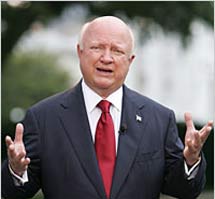
Handy Links
SLAC News Center
SLAC Today
- Subscribe
- Archives: Feb 2006-May 20, 2011
- Archives: May 23, 2011 and later
- Submit Feedback or Story Ideas
- About SLAC Today
SLAC News
Lab News
- Interactions
- Lightsources.org
- ILC NewsLine
- Int'l Science Grid This Week
- Fermilab Today
- Berkeley Lab News
- @brookhaven TODAY
- DOE Pulse
- CERN Courier
- DESY inForm
- US / LHC
SLAC Links
- Emergency
- Safety
- Policy Repository
- Site Entry Form

- Site Maps
- M & O Review
- Computing Status & Calendar
- SLAC Colloquium
- SLACspeak
- SLACspace
- SLAC Logo
- Café Menu
- Flea Market
- Web E-mail
- Marguerite Shuttle
- Discount Commuter Passes
-
Award Reporting Form
- SPIRES
- SciDoc
- Activity Groups
- Library
Stanford
Around the Bay
Transcript of Secretary Bodman's June 14 Address
 Good afternoon, and thank you all for being here—both those here in
the auditorium in Washington at the Forrestal Building and as well as
those who are participating via video at our various facilities across
the country. I've had the privilege of leading this department for a
little over a year now, and during that time I've had occasion to meet
many of you. I've also had the opportunity to visit 16 laboratories
and 10 of our other facilities around the country, so I've gotten to
most every place, not quite. And I expect to finish the opportunity
of visiting other facilities in the near future. The result of all of
this is that today seemed like a good time to take stock of where we
are as an organization, and to make some judgments as to where we are
going. I kind of think of this as a progress report, at least from my
standpoint.
Good afternoon, and thank you all for being here—both those here in
the auditorium in Washington at the Forrestal Building and as well as
those who are participating via video at our various facilities across
the country. I've had the privilege of leading this department for a
little over a year now, and during that time I've had occasion to meet
many of you. I've also had the opportunity to visit 16 laboratories
and 10 of our other facilities around the country, so I've gotten to
most every place, not quite. And I expect to finish the opportunity
of visiting other facilities in the near future. The result of all of
this is that today seemed like a good time to take stock of where we
are as an organization, and to make some judgments as to where we are
going. I kind of think of this as a progress report, at least from my
standpoint.
Even though I want to spend most of my time today discussing organizational issues, I can’t do that until I mention a few of our remarkable achievements—there really have been a number—that have been accomplished over the last year, and in so doing, to thank all of you, many of you, for your hard work to accomplish these and the dedication to our common mission that you have demonstrated.
First, after four years of work, this department was instrumental in helping to achieve the passing of the Energy Policy Act last summer, coming up on a year ago—quite an achievement, especially after many years of fruitless efforts.
Members of this department have been instrumental in the development of two major presidential initiatives: the American Competitiveness Initiative, which proposes a doubling of the government’s investment in research in the physical sciences over the next decade. And which has started the—at least as proposed by the administration, a fourteen percent or a half a billion dollar increase for the funding for the Office of Science in this department. And the Advanced Energy Initiative, which proposes to significantly increase our national investment in alternative fuel and clean energy technologies. It’s about a 22 percent increase up to a level of something above $2 billion dollars—so a sizeable increase.
Thirdly, after years of dedicated work by many of you, we, I believe, have put the Yucca Mountain project on a positive path forward that, I believe, will lead to completion in a timely manner and will allow for regular and reasonable funding for the effort from Congress, who has continued to struggle with our struggling over the problems that have beset us there.
Fourthly, over the past year we have undertaken a comprehensive review of the global nuclear energy market—the system if you will—and have developed a framework for the Global Nuclear Energy Partnership, or GNEP as we call it, which will be a new partnership, an international partnership including a number of other countries that will address the energy demands in a way that responsibly manages nuclear waste while at the same time reducing proliferation risks in the areas that we’re involved with.
And finally, we have developed the so-called Complex 2030 Initiative, which will help us transform America’s nuclear weapons stockpile in a way that reflects the extraordinary requirements of national security and safety while, at the same time, dealing with the need for cost-effective and responsive management. And I’m very optimistic about the work that NNSA has committed to do and their initial efforts—actually doing it.
All of you have achieved this and much more, and I thank you for that. In all these areas, as well as in many others, I hope that you take great pride in the trust that has been placed in us by our ultimate bosses, the American people. Read more...
SLAC Today, June 16, 2006